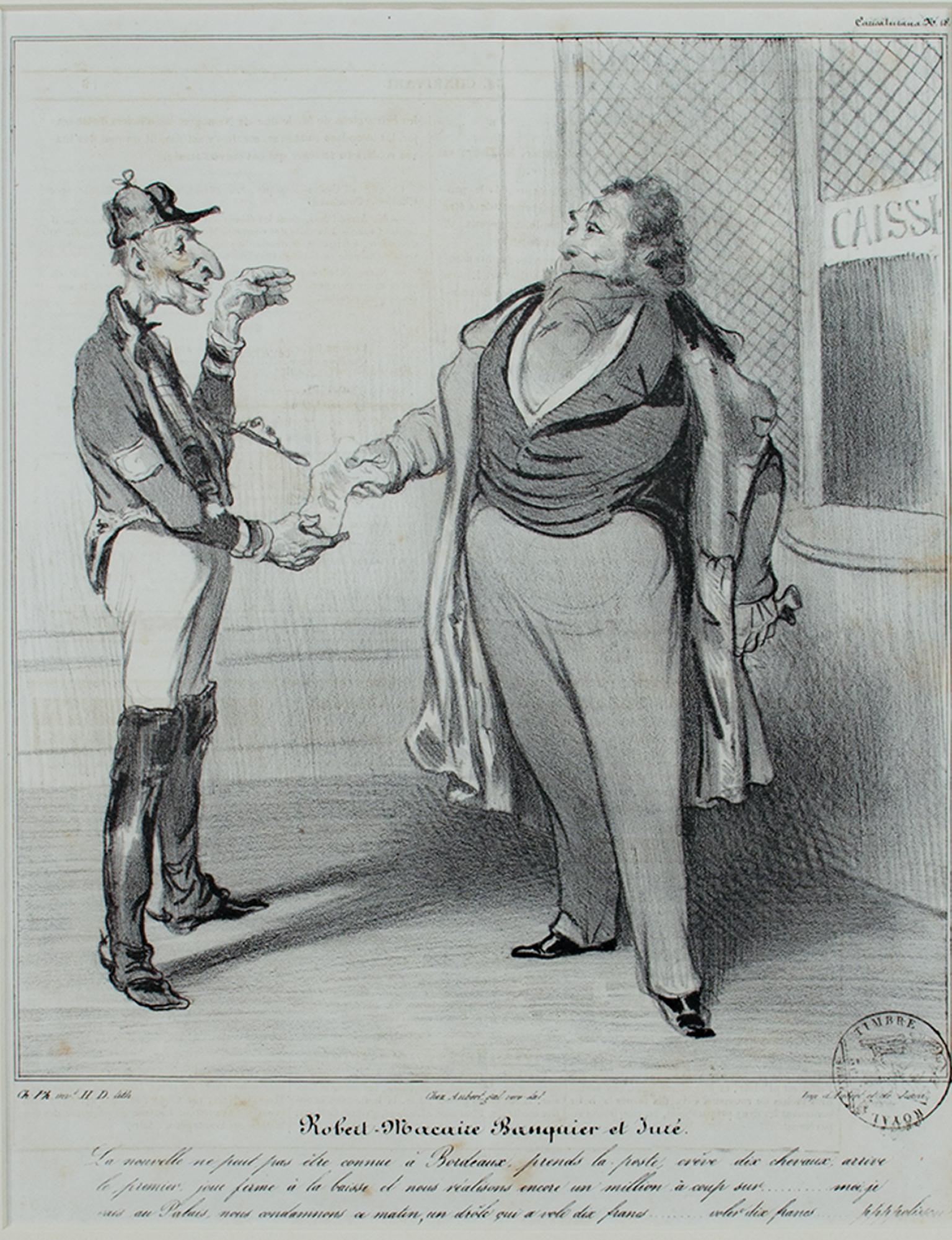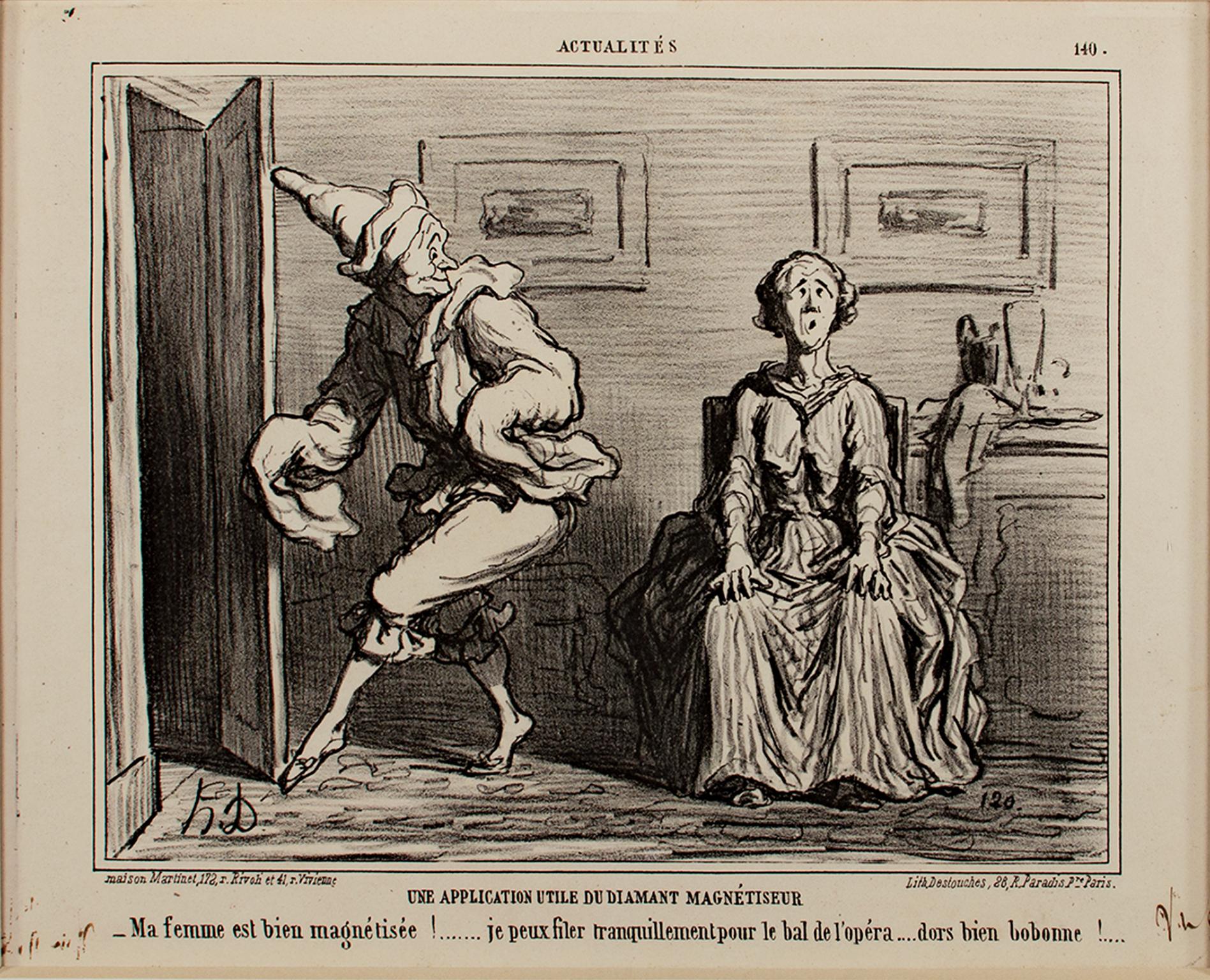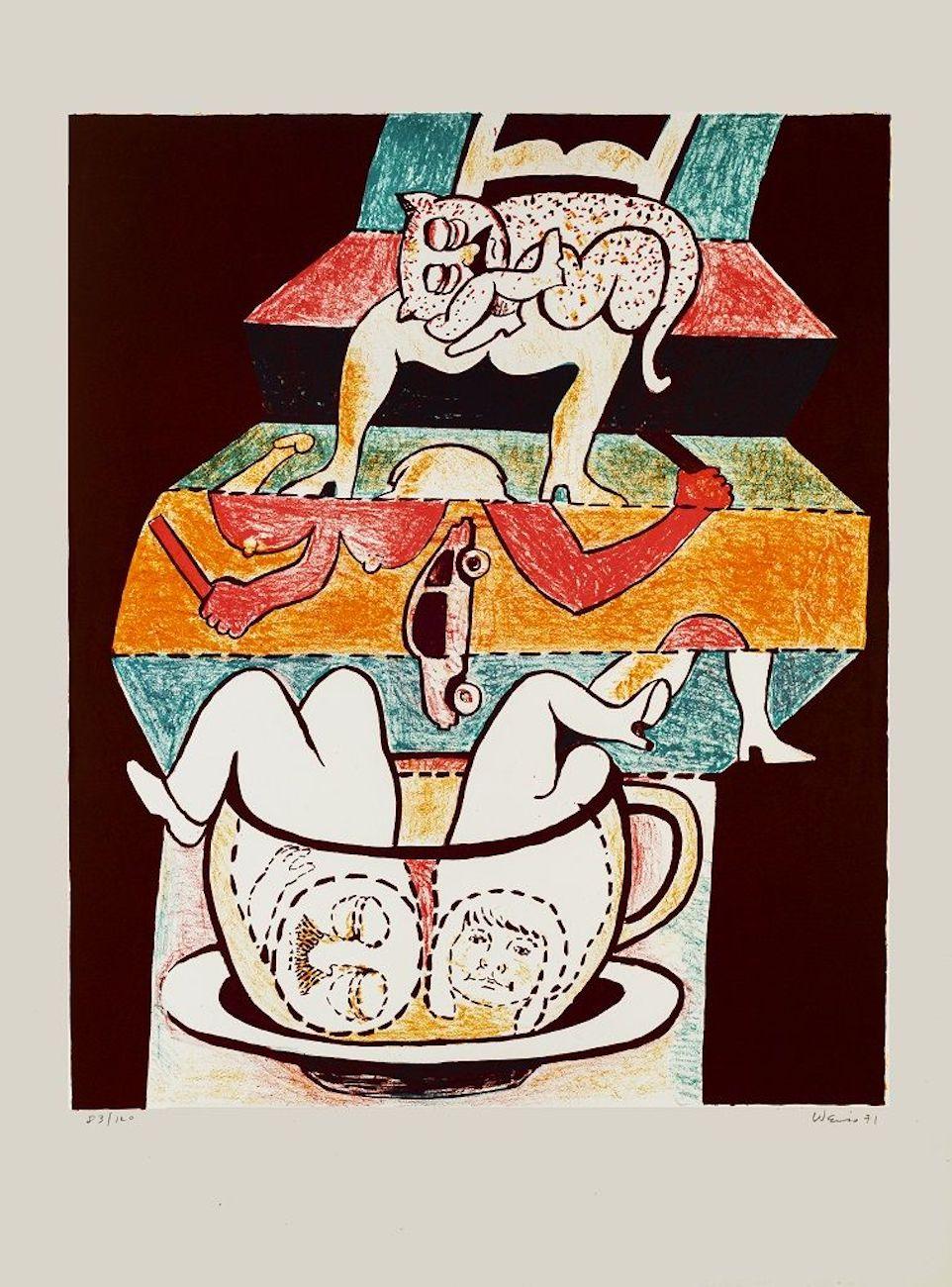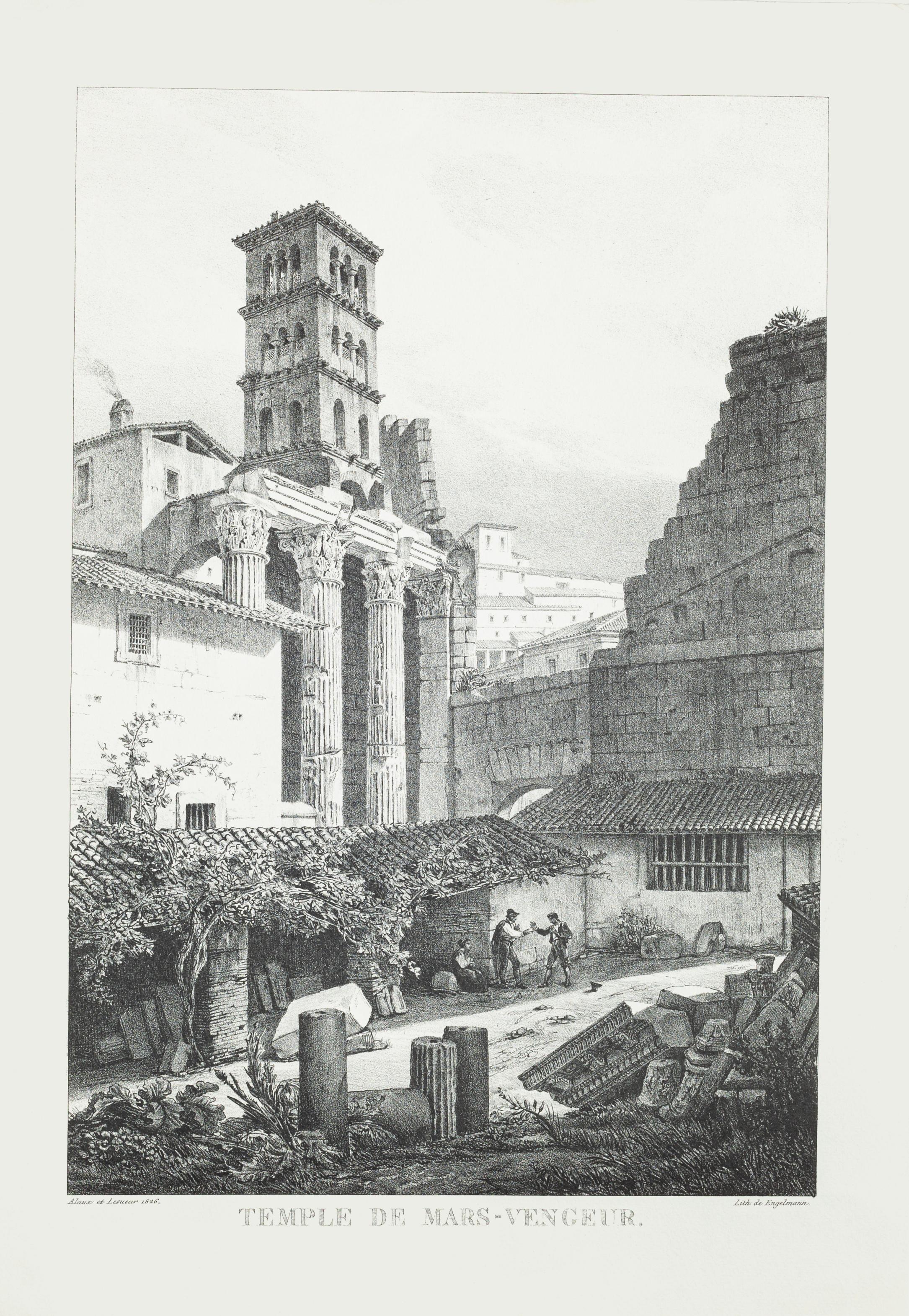Items Similar to "Robert Macaire Commis Voyageur, " Original Lithograph by Honore Daumier
Want more images or videos?
Request additional images or videos from the seller
1 of 10
Honoré Daumier"Robert Macaire Commis Voyageur, " Original Lithograph by Honore Daumier1836
1836
About the Item
"Robert Macaire Commis Voyageur" is an original lithograph by Honore Daumier. It depicts two men having a conversation.
Artwork Size: 14 1/4" x 9 1/2"
Frame Size: 21 3/4" x 18 1/2"
Artist Bio:
Daumier was a prolific draftsman who produced over 4000 lithographs, he was perhaps best known for his caricatures of political figures and satires on the behavior of his countrymen, although posthumously the value of his painting has also been recognized. His works offer a commentary on social and political life in France in the 19th century.
French caricaturist and painter, born at Marseilles. He showed in his earliest youth an irresistible inclination towards the artistic profession, which his father vainly tried to check by placing him first with a huissier, and subsequently with a bookseller. Having mastered the technique of lithography, Daumier started his artistic career by producing plates for music publishers, and illustrations for advertisements; these were followed by anonymous work for publishers, in which he followed the style of Charlet and displayed considerable enthusiasm for the Napoleonic legend. When, in the reign of Louis-Philippe, Philipon launched the comic journal, La Caricature, Daumier joined its staff, which included such powerful artists as Devéria, Raffet and Grandville, and started upon his pictorial campaign of scathing satire upon the foibles of the bourgeoisie, the corruption of the law and the incompetence of a blundering government. His caricature of the king as "Gargantua" led to Daumier's imprisonment for six months at Ste. Pélagie in 1832. The publication of La Caricature was discontinued soon after, but Philipon provided a new field for Daumier's activity when he founded the Charivari. For this journal Daumier produced his famous social caricatures, in which bourgeois society is held up to ridicule in the figure of Robert Macaire, the hero of a then popular melodrama. Another series, "L'Histoire Ancienne", was directed against the pseudoclassicism which held the art of the period in fetters. In 1848 Daumier embarked again on his political campaign, still in the service of Charivari, which he left in 1860 and rejoined in 1864. In spite of his prodigious activity in the field of caricature -- the list of Daumier's lithographed plates compiled in 1904 numbers no fewer than 3958 -- he found time for flight in the higher sphere of painting. Except for the searching truthfulness of his vision and the powerful directness of his brushwork, it would be difficult to recognize the creator of Robert Macaire, of Les Bas bleus, Les Bohémiens de Paris, and the Masques, in the paintings of "Christ and His Apostles" at the Ryks Museum in Amsterdam, or in his "Good Samaritan", "Don Quixote and Sancho Panza", "Christ Mocked", or even in the sketches in the Ionides Collection at South Kensington. But as a painter, Daumier, one of the pioneers of naturalism, was before his time, and did not meet with success until in 1878, a year before his death, when Durand-Ruel collected his works for exhibition at his galleries and demonstrated the full range of the genius of the man who has been well called the Michelangelo of caricature. At the time of this exhibition Daumier, totally blind, was living in a cottage at Valmondois, which was placed at his disposal by Corot, and where he breathed his last in 1879. An important exhibition of his works was held at the École des Beaux-Arts in 1900.
- Creator:Honoré Daumier (1808 - 1879, French)
- Creation Year:1836
- Dimensions:Height: 21.75 in (55.25 cm)Width: 18.5 in (46.99 cm)
- Medium:
- Movement & Style:
- Period:
- Framing:Frame IncludedFraming Options Available
- Condition:
- Gallery Location:Milwaukee, WI
- Reference Number:
Honoré Daumier
Honoré-Victorin Daumier is a French printmaker, caricaturist, painter and sculptor, whose many works offer commentary on the social and political life of 19th-century France. Daumier is famous for this satirical commentary through the lithographs he produced. He is best known for his caricatures of political figures. Daumier’s works are found in many of the world’s leading art museums, including the Louvre, the Metropolitan Museum of Art and the Rijksmuseum.
About the Seller
4.9
Platinum Seller
These expertly vetted sellers are 1stDibs' most experienced sellers and are rated highest by our customers.
Established in 1966
1stDibs seller since 2017
391 sales on 1stDibs
Typical response time: 1 hour
- ShippingRetrieving quote...Ships From: Milwaukee, WI
- Return PolicyA return for this item may be initiated within 14 days of delivery.
More From This SellerView All
- "Robert Macaire Banquier et Jure, " Original Lithograph by Honore DaumierBy Honoré DaumierLocated in Milwaukee, WI"Robert Macaire Banquier et Jure" is an original lithograph by Honore Daumier. It depicts a banker and his contemporary having a conversation. 1/2 D. 371 (Charivari) Artwork Size: 14 1/4" x 9 1/2" Frame Size: 21 5/8" x 19" Artist Bio: Daumier was a prolific draftsman who produced over 4000 lithographs, he was perhaps best known for his caricatures of political figures and satires on the behavior of his countrymen, although posthumously the value of his painting has also been recognized. His works offer a commentary on social and political life in France in the 19th century. French caricaturist and painter, born at Marseilles. He showed in his earliest youth an irresistible inclination towards the artistic profession, which his father vainly tried to check by placing him first with a huissier, and subsequently with a bookseller. Having mastered the technique of lithography, Daumier started his artistic career by producing plates for music publishers, and illustrations for advertisements; these were followed by anonymous work for publishers, in which he followed the style of Charlet and displayed considerable enthusiasm for the Napoleonic legend. When, in the reign of Louis-Philippe, Philipon launched the comic journal, La Caricature, Daumier joined its staff, which included such powerful artists as Devéria, Raffet and Grandville, and started upon his pictorial campaign of scathing satire upon the foibles of the bourgeoisie, the corruption of the law and the incompetence of a blundering government. His caricature of the king as "Gargantua" led to Daumier's imprisonment for six months at Ste. Pélagie in 1832. The publication of La Caricature was discontinued soon after, but Philipon provided a new field for Daumier's activity when he founded the Charivari. For this journal Daumier produced his famous social caricatures, in which bourgeois society is held up to ridicule in the figure of Robert Macaire, the hero of a then popular melodrama. Another series, "L'Histoire Ancienne", was directed against the pseudoclassicism which held the art of the period in fetters. In 1848 Daumier embarked again on his political campaign, still in the service of Charivari, which he left in 1860 and rejoined in 1864. In spite of his prodigious activity in the field of caricature -- the list of Daumier's lithographed plates compiled in 1904 numbers no fewer than 3958 -- he found time for flight in the higher sphere of painting. Except for the searching truthfulness of his vision and the powerful directness of his brushwork, it would be difficult to recognize the creator of Robert Macaire, of Les Bas bleus, Les Bohémiens de Paris, and the Masques, in the paintings of "Christ and His Apostles" at the Ryks Museum in Amsterdam, or in his "Good Samaritan", "Don Quixote and Sancho Panza", "Christ Mocked...Category
1830s Victorian Figurative Prints
MaterialsLithograph
- "Une Application Utile du Diamant Magnetiseur--Actualites" by Honore DaumierBy Honoré DaumierLocated in Milwaukee, WI"Une Application Utile Du Diamant Magnetiseur-Actualites" is an original lithograph, the second state of three, by Honore Daumier. It depicts a husband and wife pair. Artwork Size: 8 1/2" x 10 3/4" Frame Size: 17 3/4" x 20 1/4" Artist Bio: Daumier was a prolific draftsman who produced over 4000 lithographs, he was perhaps best known for his caricatures of political figures and satires on the behavior of his countrymen, although posthumously the value of his painting has also been recognized. His works offer a commentary on social and political life in France in the 19th century. French caricaturist and painter, born at Marseilles. He showed in his earliest youth an irresistible inclination towards the artistic profession, which his father vainly tried to check by placing him first with a huissier, and subsequently with a bookseller. Having mastered the technique of lithography, Daumier started his artistic career by producing plates for music publishers, and illustrations for advertisements; these were followed by anonymous work for publishers, in which he followed the style of Charlet and displayed considerable enthusiasm for the Napoleonic legend. When, in the reign of Louis-Philippe, Philipon launched the comic journal, La Caricature, Daumier joined its staff, which included such powerful artists as Devéria, Raffet and Grandville, and started upon his pictorial campaign of scathing satire upon the foibles of the bourgeoisie, the corruption of the law and the incompetence of a blundering government. His caricature of the king as "Gargantua" led to Daumier's imprisonment for six months at Ste. Pélagie in 1832. The publication of La Caricature was discontinued soon after, but Philipon provided a new field for Daumier's activity when he founded the Charivari. For this journal Daumier produced his famous social caricatures, in which bourgeois society is held up to ridicule in the figure of Robert Macaire, the hero of a then popular melodrama. Another series, "L'Histoire Ancienne", was directed against the pseudoclassicism which held the art of the period in fetters. In 1848 Daumier embarked again on his political campaign, still in the service of Charivari, which he left in 1860 and rejoined in 1864. In spite of his prodigious activity in the field of caricature -- the list of Daumier's lithographed plates compiled in 1904 numbers no fewer than 3958 -- he found time for flight in the higher sphere of painting. Except for the searching truthfulness of his vision and the powerful directness of his brushwork, it would be difficult to recognize the creator of Robert Macaire, of Les Bas bleus, Les Bohémiens de Paris, and the Masques, in the paintings of "Christ and His Apostles" at the Ryks Museum in Amsterdam, or in his "Good Samaritan", "Don Quixote and Sancho Panza", "Christ Mocked...Category
1860s Victorian Figurative Prints
MaterialsLithograph
- "Caricatura Robert Macaire Negociant, " Lithograph by Honore DaumierBy Honoré DaumierLocated in Milwaukee, WI"Caricatura Robert Macaire Negociant" is a lithograph by Honore Daumier. It was published February 24, 1837. Original Text: Robert Macaire, Négociant. Hé bien ! Monsieur Macaire, v...Category
1830s Victorian Figurative Prints
MaterialsLithograph
- 'Birchbark Sap Buckets and Yoke' original halftone print, Bureau of EthnologyLocated in Milwaukee, WIThis halftone print was included in the 1898 report of the Bureau of Ethnology to the Smithsonain Institution. The sap buckets and yoke are from the Menomin...Category
1890s Victorian Figurative Prints
MaterialsLithograph
- Derriere Le MiroirBy Saul SteinbergLocated in Milwaukee, WI"Derriere Le Miroir" is an original color lithograph created by the artist Saul Steinberg. Edition: 53/150 Artwork Size: 14"x 20" Frame Size: 33 1/8"x 25 5/8" From the Saul Steinb...Category
1970s Contemporary Figurative Prints
MaterialsInk, Lithograph
- Original Lithograph Baby Life Moments Family Female Figure Mother Black SignedBy Jean CharlotLocated in Milwaukee, WI"First Steps" is an original lithograph created by Jean Charlot. This is a wonderful piece with hispanic styling, showing a mother teaching her child how to walk. The mother is shown...Category
1930s Other Art Style Figurative Prints
MaterialsPaper, Ink, Lithograph
You May Also Like
- Breakdown Figures - Original Lithograph by Hugh Weiss - 1971By Hugh WeissLocated in Roma, ITBreakdown Figures is an original colored lithograph realized by Hugh Weiss in 1971. Hand-signed and dated by the artist on the lower right corner. Numbered on the lower-left corner (83/120). The artwork represents a very funny composition with different breakdown figures: a couple dipped upside down in a giant cup...Category
1970s Contemporary Figurative Prints
MaterialsLithograph
- Temple of Mars - Offset on Paper by G. Engelmann - 1826By G. EngelmannLocated in Roma, ITTemple of Mars is offset print artwork on paper, realized by G. Engelmann in 1826, the artwork is signed on the plate and dated. In very good condition. The artwork represents the roman landscape of the temple of Mars, The temple of Mars in the Circus was a temple of ancient Rome dedicated to Mars, located near the Circus Flaminio, in the IX Augustan region. the temple contained a colossal statue of...Category
1820s Figurative Prints
MaterialsLithograph
- Workshop - Original Lithograph by Giuseppe Megna - 1980 ca.By Giuseppe MegnaLocated in Roma, ITWorkshop is an original lithograph on paper realized by Giuseppe Megna in 1980 ca. Hand-signed on the lower right and dated, numbered on the lower left in pencil, edition of 4/100 p...Category
1980s Figurative Prints
MaterialsLithograph
- Robert Longo, Black Palms - Lithograph from 1989, Signed PrintBy Robert LongoLocated in Hamburg, DERobert Longo (American, born 1953) Black Palms, 1989 Medium: Lithograph on rag paper Dimensions: 169 x 127 cm (66½ x 50 in) Edition of 35: Hand-signed and numbered Condition: ExcellentCategory
20th Century Contemporary Figurative Prints
MaterialsLithograph
- STREET SCENE Signed Lithograph, NYC Crowd Portrait Pencil Drawing, A-Line SkirtsBy Raphael SoyerLocated in Union City, NJSTREET SCENE, NYC Crowd, is an original, hand drawn lithograph by Raphael Soyer, the renowned Russian-born American realist painter, draftsman, and printmaker. Printed using traditio...Category
1970s Realist Figurative Prints
MaterialsLithograph
- Marc Chagall - Original LithographBy Marc ChagallLocated in Collonge Bellerive, Geneve, CHMarc Chagall Original Lithograph 1963 Dimensions: 32 x 24 cm Reference: Chagall Lithographe 1957-1962. VOLUME II. Unsigned edition of over 5,000 Condition : Excellent Marc Chagall (born in 1887) Marc Chagall was born in Belarus in 1887 and developed an early interest in art. After studying painting, in 1907 he left Russia for Paris, where he lived in an artist colony on the city’s outskirts. Fusing his own personal, dreamlike imagery with hints of the fauvism and cubism popular in France at the time, Chagall created his most lasting work—including I and the Village (1911)—some of which would be featured in the Salon des Indépendants exhibitions. After returning to Vitebsk for a visit in 1914, the outbreak of WWI trapped Chagall in Russia. He returned to France in 1923 but was forced to flee the country and Nazi persecution during WWII. Finding asylum in the U.S., Chagall became involved in set and costume design before returning to France in 1948. In his later years, he experimented with new art forms and was commissioned to produce numerous large-scale works. Chagall died in St.-Paul-de-Vence in 1985. The Village Marc Chagall was born in a small Hassidic community on the outskirts of Vitebsk, Belarus, on July 7, 1887. His father was a fishmonger, and his mother ran a small sundries shop in the village. As a child, Chagall attended the Jewish elementary school, where he studied Hebrew and the Bible, before later attending the Russian public school. He began to learn the fundamentals of drawing during this time, but perhaps more importantly, he absorbed the world around him, storing away the imagery and themes that would feature largely in most of his later work. At age 19 Chagall enrolled at a private, all-Jewish art school and began his formal education in painting, studying briefly with portrait artist Yehuda Pen. However, he left the school after several months, moving to St. Petersburg in 1907 to study at the Imperial Society for the Protection of Fine Arts. The following year, he enrolled at the Svanseva School, studying with set designer Léon Bakst, whose work had been featured in Sergei Diaghilev's Ballets Russes. This early experience would prove important to Chagall’s later career as well. Despite this formal instruction, and the widespread popularity of realism in Russia at the time, Chagall was already establishing his own personal style, which featured a more dreamlike unreality and the people, places and imagery that were close to his heart. Some examples from this period are his Window Vitebsk (1908) and My Fianceé with Black Gloves (1909), which pictured Bella Rosenfeld, to whom he had recently become engaged. The Beehive Despite his romance with Bella, in 1911 an allowance from Russian parliament member and art patron Maxim Binaver enabled Chagall to move to Paris, France. After settling briefly in the Montparnasse neighborhood, Chagall moved further afield to an artist colony known as La Ruche (“The Beehive”), where he began to work side by side with abstract painters such as Amedeo Modigliani and Fernand Léger as well as the avant-garde poet Guillaume Apollinaire. At their urging, and under the influence of the wildly popular fauvism and cubism, Chagall lightened his palette and pushed his style ever further from reality. I and the Village (1911) and Homage to Apollinaire (1912) are among his early Parisian works, widely considered to be his most successful and representative period. Though his work stood stylistically apart from his cubist contemporaries, from 1912 to 1914 Chagall exhibited several paintings at the annual Salon des Indépendants exhibition, where works by the likes of Juan Gris, Marcel Duchamp and Robert Delaunay were causing a stir in the Paris art world. Chagall’s popularity began to spread beyond La Ruche, and in May 1914 he traveled to Berlin to help organize his first solo exhibition, at Der Sturm Gallery. Chagall remained in the city until the highly acclaimed show opened that June. He then returned to Vitebsk, unaware of the fateful events to come. War, Peace and Revolution In August 1914 the outbreak of World War I precluded Chagall’s plans to return to Paris. The conflict did little to stem the flow of his creative output, however, instead merely giving him direct access to the childhood scenes so essential to his work, as seen in paintings such as Jew in Green (1914) and Over Vitebsk (1914). His paintings from this period also occasionally featured images of the war’s impact on the region, as with Wounded Soldier (1914) and Marching (1915). But despite the hardships of life during wartime, this would also prove to be a joyful period for Chagall. In July 1915 he married Bella, and she gave birth to a daughter, Ida, the following year. Their appearance in works such as Birthday (1915), Bella and Ida by the Window (1917) and several of his “Lovers” paintings give a glimpse of the island of domestic bliss that was Chagall’s amidst the chaos. To avoid military service and stay with his new family, Chagall took a position as a clerk in the Ministry of War Economy in St. Petersburg. While there he began work on his autobiography and also immersed himself in the local art scene, befriending novelist Boris Pasternak, among others. He also exhibited his work in the city and soon gained considerable recognition. That notoriety would prove important in the aftermath of the 1917 Russian Revolution when he was appointed as the Commissar of Fine Arts in Vitebsk. In his new post, Chagall undertook various projects in the region, including the 1919 founding of the Academy of the Arts. Despite these endeavors, differences among his colleagues eventually disillusioned Chagall. In 1920 he relinquished his position and moved his family to Moscow, the post-revolution capital of Russia. In Moscow, Chagall was soon commissioned to create sets and costumes for various productions at the Moscow State Yiddish...Category
1960s Surrealist Figurative Prints
MaterialsLithograph
Recently Viewed
View AllMore Ways To Browse
Victorian Illustration
Michelangelo Original
Victorian Antique Illustrations
Daumier Daumier
French Print Advertisement
Victorian Museum Display
Honore Daumier
Daumier Artist
Plate Christ
Daumier Lithographs
19th Century Victorian Cottage Paintings
Honore Daumier Lithographs
1900 Advertisement
Kensington Print
Don Quixote Lithograph
Apostles Painting
Political Comic
Le Christ






